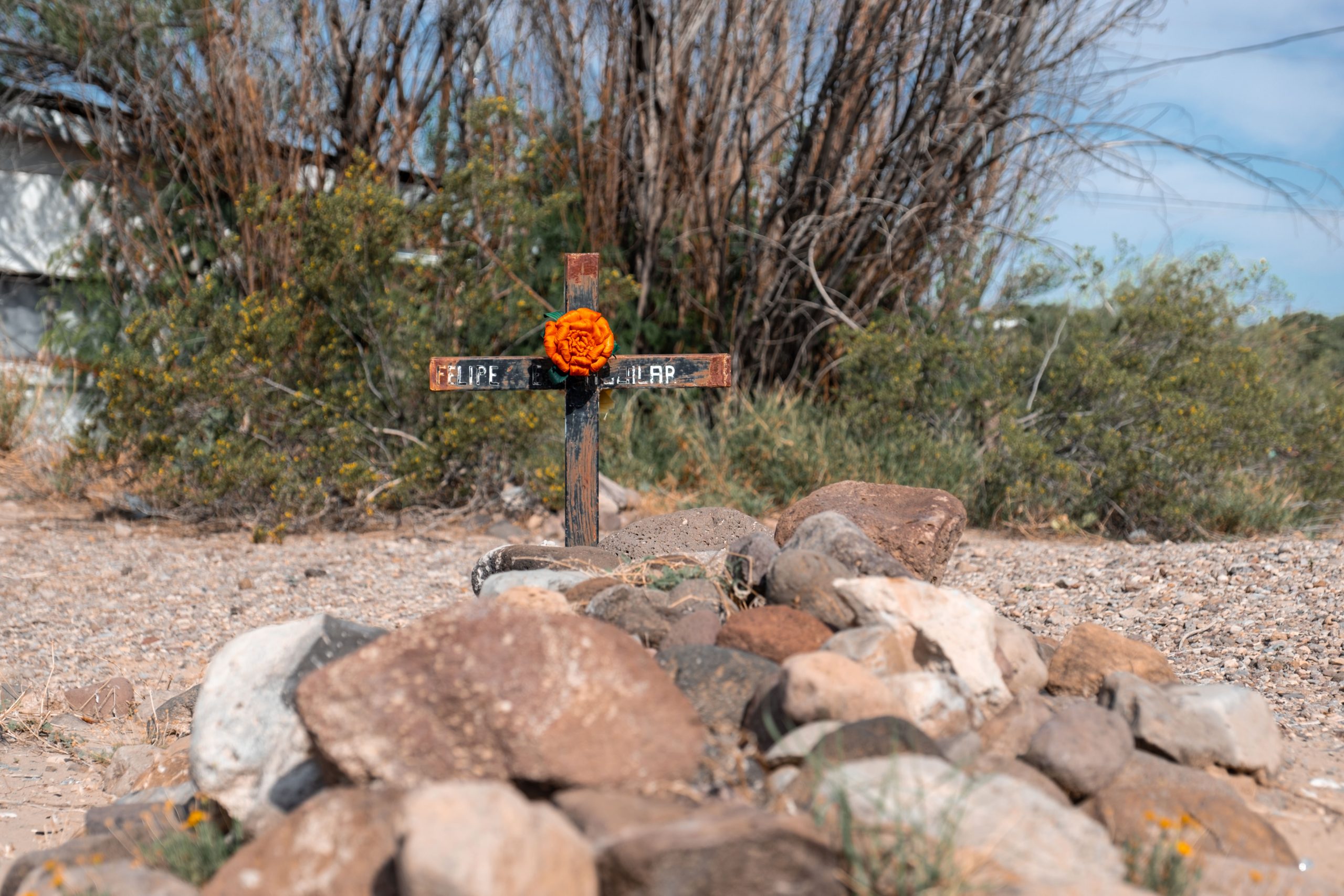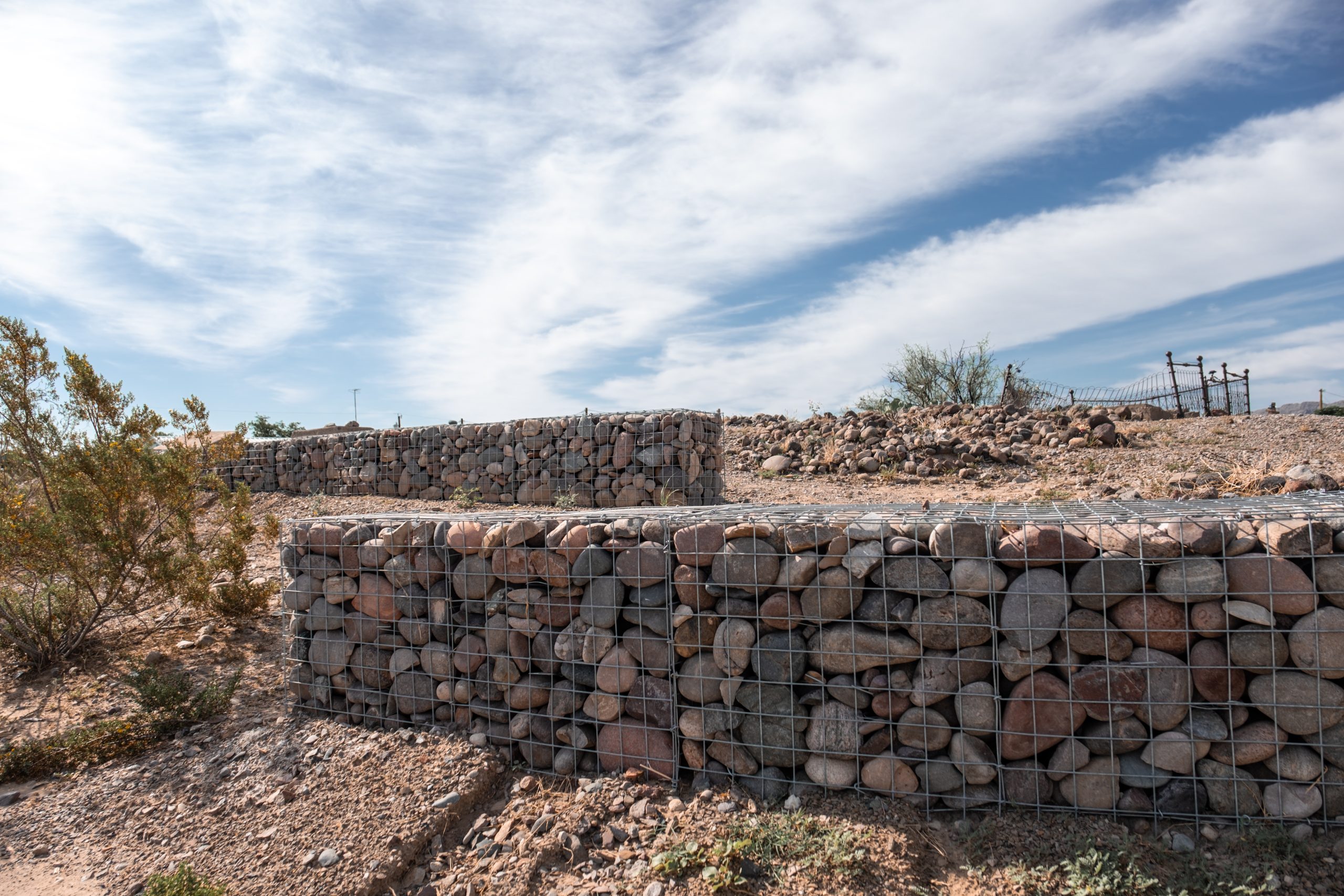
The Aguilar family graves are the only two marked graves in El Cementerio del Barrio de los Lipanes. Photo by Sarah Vasquez.
Growing up, Christina Hernandez spent the summer with her grandparents in the West Texas border town of Presidio, 60 miles south of Marfa. Each week, she would visit El Cementerio del Barrio de los Lipanes (the Cemetery of the Lipan Neighborhood), where her ancestors are buried, and pick up the litter that was left behind.
“It was a constant thing,” said Hernandez, who I spoke with at the Agave Festival in Marfa last month. “We would drive by. We’d see fresh trash. We’d stop and clean up.”
Hernandez was on a panel to discuss the preservation efforts for the cemetery at the festival, along with Oscar Rodriguez, an enrolled member of the Lipan Apache Tribe; Xoxi Nayapiltzin, a descendant of aboriginal people of La Junta; Mayrah Udvardi, senior architect at MASS Design Group; and Joseph Kunkel, principle at MASS Design Group.
The cemetery, located on the corner of Market Street and Barton Avenue, is a sacred burial site for the Lipan Apache Tribe of Texas, who migrated south from Canada over a thousand years ago and settled along the Colorado and Concho rivers. Some of the tribe moved further south to escape the Comanche. This group, the Prairie Grass Band, eventually relocated along the Rio Grande in sister cities Presidio and Ojinaga, as result of a peace settlement with the Spanish settlers in the 1790s.
The cemetery was the Lipan Apaches’ final resting place and remained undisturbed until the 1970s when the burial mound was excavated for housing development that created the surrounding neighborhoods, roads, and alleys. While the current mound stands almost as tall as the adjacent homes, Rodriguez said during the panel that the mound was eight times the size. It was much higher and descended into the next block.
When I followed up with him about the size, Rodriguez guessed it used to encompass about 4 acres of surface. Back in the late 1960s, when he used to walk by there, the graves would be “dispersed throughout the mound generally east-west-facing right up to an arroyo that used to border it on the east (now Wilkinson Street),” he told me.
After the city of Presidio incorporated in the 1980s, Enrique Madrid, a Redford resident and historian, and other descendants of the Lipan Apache objected to further encroachment on the property. As a result, Market Street, which is north of the cemetery, slightly curves around rather than goes straight.
According to an archaeological study, there are at least 45 graves on the mound, with possibly 12 more. To Hernandez, this cemetery is known as the Aguilar cemetery as her great-great-grandfather and his brother are the only marked graves on the site. Each one is covered with piles of sacred “sentinel” rocks that provide spiritual and physical protection, a Lipan Apache custom. Over the years though, locals were taking the rocks offsite for landscaping, and Hernandez also noticed signs of erosion and grooves in the dirt from bikes.
This inspired the idea to build some sort of protective barrier to preserve the remaining burial mound. She contacted Rodriguez, then tribal administrator, to seek the tribe’s support in writing a letter to the Texas Historical Commission. The state agency designated the cemetery as a State Antiquities Landmark in 2014 and a historical marker written by Rodriguez, the first written by an Indigenous voice, was submitted in 2020 and will be installed at the site closer to the project completion early next year.
But then Rodriguez learned from THC’s archeological division that the fence project couldn’t proceed because it would exclude the remains outside the proposed parameters. However, the commission approved a protective structure that didn’t require foundation or stakes into the ground.
“That really limited what kind of fencing we could do,” Hernandez said.
The tribe continued with their preservation efforts and partnered with Big Bend Conservation Alliance, an organization that works to conserve regional heritage and resources. The Presidio County Commissioners Court and Presidio City Council voted to transfer ownership of the cemetery to the Lipan Apache tribe in 2021.

Wire baskets filled with rocks are being placed around the cemetery to provide protection and navigation guidance. Photo by Sarah Vasquez
The alliance commissioned MASS (Model of Architecture Serving Society) Design Group, a nonprofit architecture and design firm whose mission is to research, build, and advocate for architecture that promotes justice and human dignity, to design a space that provides protection as well as helps people feel welcome to navigate the cemetery. Udvardi, who I also spoke with at the Agave Festival, said constructing a fence with Gabion wire baskets filled with sentinel rocks was the logical approach. They could be installed throughout the space without disrupting the existing graves and vegetation that includes creosote.
“Here we have a mass that allows you to build on top of what’s existing without going deeper than six inches max and still provides enough critical mass that it’s shoring up the ground to prevent erosion,” said Udvardi.
The foundational support for the cemetery is currently under construction with the next phase starting in July that will include building the rest of the walls that will guide visitors along the north and south access to the cemetery. There will be interpretive signage that has yet to be determined by the community. When the cemetery reopens to the public tentatively early next year, visitors will be invited to pick up a sentinel stone at the entrance and deposit it onto one of the existing burial mounds.
“For many, many years, there was this passive removal or intentional removal of stones from the site, and so there’s this tributary of these stones that once covered graves and properties all across the area here,” Udvardi said. “[The tribe] led an initiative several years ago to try to reclaim as many of those as possible and that’s an ongoing thing.”
When Annie Rosenthal, panel moderator and Marfa Public Radio border reporter, asked the panelists at the Agave Festival what their vision is for the site, Hernandez shared the words of her abuelita: “Please don’t forget. Go and visit them and let them know that you remember.”
She added, “When I’m sitting here, I know that all of you will remember, and through the site, people will continue to remember who’s there.”








